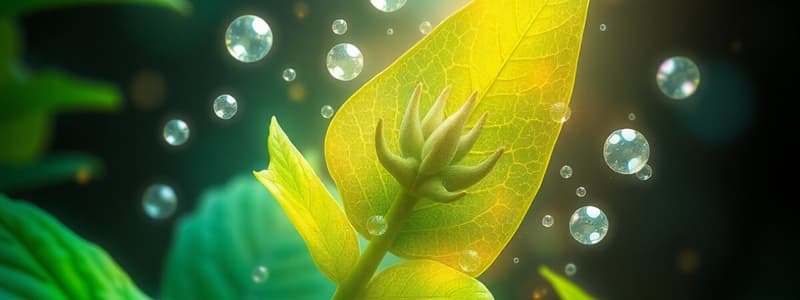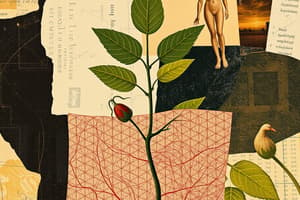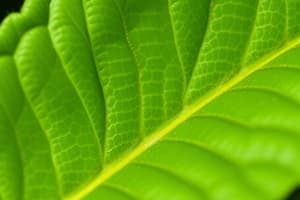Podcast
Questions and Answers
What is the primary function of the cuticle in plants?
What is the primary function of the cuticle in plants?
- Nutrient absorption
- Prevention of water loss (correct)
- Gas exchange
- Photosynthesis
Which of the following statements about the cuticle is NOT true?
Which of the following statements about the cuticle is NOT true?
- It aids in photosynthesis. (correct)
- It can affect the rate of transpiration.
- It serves as a protective layer.
- It helps maintain internal moisture.
How does the cuticle contribute to a plant's survival in dry environments?
How does the cuticle contribute to a plant's survival in dry environments?
- By enhancing nutrient absorption
- By facilitating gas exchange
- By promoting growth in foliage
- By preventing excessive water loss (correct)
In addition to preventing water loss, what is another role of the cuticle?
In addition to preventing water loss, what is another role of the cuticle?
What characteristic makes the cuticle a critical adaptation for terrestrial plants?
What characteristic makes the cuticle a critical adaptation for terrestrial plants?
Which of the following is NOT a characteristic shared by green algae and plants?
Which of the following is NOT a characteristic shared by green algae and plants?
Which statement accurately describes green algae in relation to plants?
Which statement accurately describes green algae in relation to plants?
Which process involves the conversion of light energy into chemical energy in plants?
Which process involves the conversion of light energy into chemical energy in plants?
What storage form of carbohydrates do green algae and plants have in common?
What storage form of carbohydrates do green algae and plants have in common?
What is the primary role of the protective structures surrounding a plant embryo?
What is the primary role of the protective structures surrounding a plant embryo?
Which division of plants encompasses all flowering plants?
Which division of plants encompasses all flowering plants?
Which characteristic is common to both green algae and plants?
Which characteristic is common to both green algae and plants?
What function do roots primarily serve in plants?
What function do roots primarily serve in plants?
In terms of cellular structure, which of these is false about green algae and plants?
In terms of cellular structure, which of these is false about green algae and plants?
Which of the following is NOT typically associated with the process of gas exchange in plants?
Which of the following is NOT typically associated with the process of gas exchange in plants?
Which division includes conifers?
Which division includes conifers?
Which division primarily includes flowering plants?
Which division primarily includes flowering plants?
Which of the following divisions is known for its cycads?
Which of the following divisions is known for its cycads?
Which reproductive adaptation is characteristic of seed plants?
Which reproductive adaptation is characteristic of seed plants?
Ginkgo biloba belongs to which division?
Ginkgo biloba belongs to which division?
Which statement correctly describes Coniferophyta?
Which statement correctly describes Coniferophyta?
What is true about vascular plants?
What is true about vascular plants?
Which of the following statements about Coniferophyta is incorrect?
Which of the following statements about Coniferophyta is incorrect?
Which group do vascular plants not belong to?
Which group do vascular plants not belong to?
Which of the following is a characteristic of non-seed vascular plants?
Which of the following is a characteristic of non-seed vascular plants?
Flashcards
Vision
Vision
The central belief that guides the school's actions and goals.
Mission
Mission
A statement outlining how the school will achieve its vision.
Modern Education
Modern Education
A key element of the school's mission, focusing on modern teaching methods.
Attractive Educational Environment
Attractive Educational Environment
Signup and view all the flashcards
Influential Community Participation
Influential Community Participation
Signup and view all the flashcards
What is the cuticle's purpose?
What is the cuticle's purpose?
Signup and view all the flashcards
Cuticle Function
Cuticle Function
Signup and view all the flashcards
Cuticle
Cuticle
Signup and view all the flashcards
Cuticle and Transpiration
Cuticle and Transpiration
Signup and view all the flashcards
What the cuticle DOESN'T do?
What the cuticle DOESN'T do?
Signup and view all the flashcards
Cellulose cell walls
Cellulose cell walls
Signup and view all the flashcards
Chlorophyll a
Chlorophyll a
Signup and view all the flashcards
Movement using cilia
Movement using cilia
Signup and view all the flashcards
Starch as food storage
Starch as food storage
Signup and view all the flashcards
Difference in movement
Difference in movement
Signup and view all the flashcards
Photosynthesis
Photosynthesis
Signup and view all the flashcards
Gas exchange
Gas exchange
Signup and view all the flashcards
Seed coat
Seed coat
Signup and view all the flashcards
Anchoring
Anchoring
Signup and view all the flashcards
Anthophyta
Anthophyta
Signup and view all the flashcards
Which division includes conifers?
Which division includes conifers?
Signup and view all the flashcards
What is a reproductive adaptation of seed plants?
What is a reproductive adaptation of seed plants?
Signup and view all the flashcards
What is the cuticle's function?
What is the cuticle's function?
Signup and view all the flashcards
What does the cuticle NOT do?
What does the cuticle NOT do?
Signup and view all the flashcards
Is Coniferophyta a division of flowering plants?
Is Coniferophyta a division of flowering plants?
Signup and view all the flashcards
How are vascular plants divided?
How are vascular plants divided?
Signup and view all the flashcards
What are vascular plants?
What are vascular plants?
Signup and view all the flashcards
How do non-seed plants reproduce?
How do non-seed plants reproduce?
Signup and view all the flashcards
What's special about seed plants?
What's special about seed plants?
Signup and view all the flashcards
Study Notes
Plant Biology Worksheet
- Cuticle Purpose: Prevents water loss.
- Characteristic Shared by Green Algae and Plants: Cell walls made of cellulose, use of a similar type of chlorophyll, store food as starch.
- Plant Tissue for Substance Movement: Vascular tissue.
- Gas Exchange in Plants: Stomata allow gas exchange despite the cuticle.
- Moss Classification: Nonvascular plants.
Seed Function
- Seed Primary Function: Protecting the embryo and nutrients.
Plant Divisions
- Flowering Plant Division: Anthophyta.
- Damp, Shady Plant: Nonvascular plants.
- Horsetail Unique Structure: Strobili.
- Conifer Division: Coniferophyta.
- Seed Plant Reproductive Adaptation: Waterproof protective coverings on spores.
- Seedless Plant Type: Seedless vascular plants.
Cotyledon
- Cotyledons: Structures that store or absorb food for a sporophyte.
Hornwort Division
- Hornwort Division: Anthocerophyta.
Seedless Vascular Plant Example
- Seedless Vascular Plant: Fern.
Plant Structure and Function True/False
- Plant Food Storage: Plants store food as starch - True.
- Nonvascular Plant Transport: Nonvascular plants do not have specialized transport tissues- False.
- Stomata Location: Stomata are found on plant leaves, not roots - False.
- Seed Survival: Seeds enable plants to survive harsh environments - True.
- Bryophyta and Ferns: Bryophyta does not include ferns - False.
- Algae and Plant RNA: Green algae and land plants share similar ribosomal RNA genes- True.
- Rhizoids and Photosynthesis: Rhizoids are not for photosynthesis - False
- Largest & Most Diverse Plant Group: Anthophyta is the largest and most diverse group of plants - True.
- Flowering Plant Division: Coniferophyta is not a flowering plant division - False.
- Vascular Plant Groups: Vascular plants are divided into seed and non-seed groups- True.
Studying That Suits You
Use AI to generate personalized quizzes and flashcards to suit your learning preferences.




